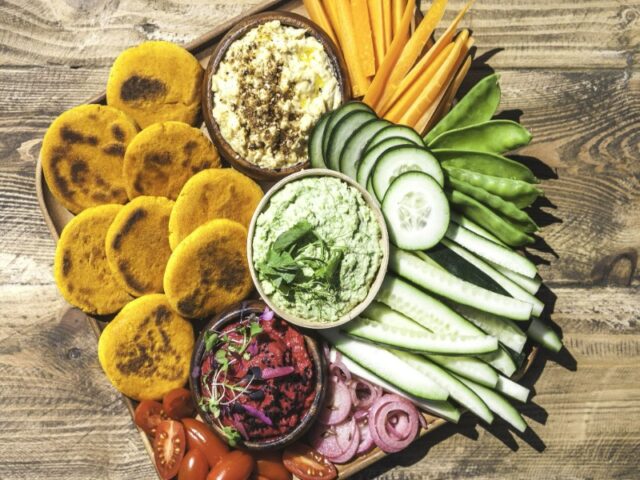Discover the Magic of High Volume Foods

Introduction
Embark on a culinary and turbojet adventure designed to satisfy your hunger without compromising your health to any degree by exploring the world of high volume food. This unique and essential approach to eating focuses on foods that are not only nutritious but also filling, allowing you to consume larger portions while still managing your calorie intake. High volume foods that are rich in water and fiber offer a way to fill your plate and stomach without overloading with calories. Of course, they are the secret weapon for those who want to maintain a balanced diet and even lose weight or simply lead a healthier lifestyle. Dive into that realm of fruits, vegetables, and even whole grains and lean proteins that exemplify the magic of High volume foods. As a first step, begin by understanding how these High Volume Foods foods can transform all of your eating habits, providing you with satisfaction and nourishment in every bite. Get ready to redefine your entire relationship with food, where abundance meets health and hunger meets its match.
Minimize Calories with High Volume Foods
High volume food can certainly emerge as a game changer. The power of all these High volume foods and how they can all transform your eating habits. High volume foods are usually high in water and fiber but low in calories. All of these high volume foods typically include greens, berries, cucumbers, and broth-based soups. A key element would be where the primary advantage of High volume foods may lie in their ability to promote satiety. High volume foods are often nutrient-dense, yet provide essential and needed vitamins and minerals while keeping the calorie count low. High volume foods can play a key role in this aspect. The power of High volume foods certainly lies in their ability to provide satiety, as well as nutritional benefits, and aid in weight management without adding to the caloric burden. High volume foods are certainly great choices to include in your dietary repertoire.
Revolutionize Your Eating with High Volume Low Calorie Foods
In today’s health-conscious world, revolutionizing your eating habits with just as much high volume low calorie foods has certainly become a game-changer. This holistic approach not only helps with weight management but normally ensures that you are full and nourished. High volume low calorie foods that are packed with nutrients, fiber, and water certainly allow you to enjoy much larger portions without feeling guilty about excess calorie intake. This unique combination creates a feeling of satiety, which reduces the likelihood of overeating. This group includes leafy greens, berries, and cucumbers as well as broth-based soups. All these foods are not only satiating, they also provide essential nutrients and, of course, vitamins.
The benefits of these effective foods in your diet.
Weight management: By eating foods with as few calories per bite as possible, you can always eat significantly larger portions without consuming too many calories, all while helping you lose weight or maintain it.
- Enhanced satiety: The high content of dietary fiber in these foods allows you to feel fuller for longer and also reduces your desire and tendency to snack on high-calorie foods.
- Nutrient-Dense Choices: Low-calorie, high volume foods are often rich in all the essential vitamins, minerals, and antioxidants, and can even be said to promote your overall health.
- Boosting hydration: Many of these foods have a high water content, which helps keep you hydrated.
How to incorporate high-volume, low-calorie foods into your diet
- Start with salads: Start your morning meals with a big salad filled with leafy greens and a variety of vegetables. It’s a great and efficient way to fill up before reaching for higher calorie options.
- Snack smart: Choose some fruit like watermelon or berries for a snack, which are low in calories but very high in water and fiber.
- Soup: Start those really important meals with a soup-based soup. It’s a pretty tasty way to increase your whole vegetable intake and fill you up.
- Bulking Meals: A key element has been to add vegetables to your main dishes so you can bulk up. French fries, casseroles, and any pasta dishes can be topped off simply with vegetables that have a lot of volume.
Although low-calorie can be interrogating, high volume foods are quite beneficial, it is an essential element to ensure that you are getting enough protein as well as healthy fats in your diet. They are quite necessary for maintaining your muscles and overall health. It is also important to listen to your body’s signs of hunger and any satiety; eating large amounts of food can certainly be uncomfortable if not done carefully. Embracing all high volume low calorie foods in bulk is a very sustainable and effective way to revolutionize your eating habits. This holistic approach not only helps maintain a healthy weight but also contributes to overall well-being. Including these foods in your diet can certainly be a wonderful as well as nutritional journey towards a healthier lifestyle. This way of eating is quite complicated but on the other hand, it can be effective, and what is important is not to forget to enjoy all those varied flavors of these dishes, making your meals a healthy and pleasant experience with the unique high volume foods.
Discovering Foods with 0 Calories for Your Diet
In an increasingly health- and wellness-conscious world, the allure of foods with 0 calories captivates many. These seemingly miraculous foods certainly promise eating pleasure without any extra calorie count. However, it is a very important factor to delve deeper into what these foods are or how they can fit into a balanced diet although this can be quite effective in so many senses it is also important to give a lot of credit on the high volume foods as well.
It is believed that foods with 0 calories, quite often called “negative calorie” foods, contain even fewer calories than the body uses to digest them. Although no food is likely to contain zero calories, many of these foods are low enough in calories that their impact is quite negligible. They certainly include a certain number of fruits and vegetables, which are rich in fiber and water, but low in calories.
The unique concept of food with zero calories
- Vegetables: Celery, cucumbers as well as leafy greens such as spinach and lettuce are often cited as examples. They are not only low-calorie but also rich in many vitamins and minerals.
- Fruit: Watermelon, strawberries as well as grapefruit are fruits that are low in calories, but have a very high content of water and nutrients.
- Herbs and spices: Although not eaten in large quantities, herbs such as parsley, and spices such as chili pepper provide a unique flavor without significantly increasing calorie intake.
Including foods with 0 calories in your diet to some extent can be a smart way to reduce your overall intake of all those calories while still consuming at least the essential nutrients. These foods are normally ideal for snacking as they can satisfy hunger without loading up on any calories. They are also quite perfect for bulking up those effective meals, such as adding volume to salads, soups, and stir-fries.
The true value of these foods, of course, lies not only in their low-calorie content but also in their nutritional density. They provide many essential vitamins, minerals as well as antioxidants, which are crucial for overall health. Their fairly high fiber content also certainly aids digestion and can even help maintain healthy blood sugar levels.
It is quite delusional that one can eat such unlimited amounts of all these foods without suffering any consequences. Although they are low in calories, all of this over-consumption can lead to unpleasant digestive problems and can fall short of providing all those necessary nutrients that your body needs. Therefore, of course, they should be part of that varied and balanced diet. Foods with 0 calories offer a fascinating and turbulent path for those who want to manage their weight and of course, improve their nutrition. Relatively speaking, they are a testament to nature’s ability to provide any number of nutritious options for health-conscious individuals.
However, it’s important to approach them with a fairly balanced perspective, understanding that while all of these nutrients are low in calories, they’re only one part of this holistic approach to nutrition and health. Embracing these foods can certainly lead to a healthier lifestyle, but always remember, that moderation and variety are key to any successful diet is simply to follow all the recommendations about the high volume foods.
The Art of Balanced Meals with Low Calorie High Protein Meal

In the realm of all that healthy eating, mastering the art of effectively balanced meals is crucial. Incorporating low calorie high protein meal that can contain high protein and high volume foods into your diet can certainly transform your eating habits and overall health in detail. This approach not only supports all weight management but also improves satiety and nutrient intake. Turbulence around high protein meals and high volume foods.
Low calorie high protein meal that contain a high protein content are certainly necessary for maintaining muscle mass and boosting metabolism, while foods with a fairly large amount, rich in fiber and water, satiate you to a certain extent without adding excessive calories. Combining these two types of effective foods certainly creates meals that are both nutritionally dense as well as voluminous, providing a sense of satiety and satisfaction after eating.
All the necessary benefits of high volume foods
- High-volume foods, such as leafy greens, cucumbers, and berries, are low in calories but high in volume, making them ideal candidates for weight loss and maintenance. They help control relatively speaking hunger pangs and reduce that goal’s overall calorie intake while providing essential nutrients. These foods improve digestion and hydration to some extent due to their high water content.
- A well-prepared low-calorie, high-protein meal with a large amount of food can of course include grilled chicken or tofu (protein), a large salad filled with spinach, or tomatoes and cucumbers (large volume) so of course it belongs here. and a small serving of quinoa or brown rice (complex carbohydrates). This combination provides you with a relatively balanced mix of macronutrients as well as filling without being overly caloric.
Incorporating high volume foods into your required diet
- 1. Start with salads: As a start, it is quite good to start the day with a salad that is full of food in large amounts. This will certainly help you feel full faster or reduce the likelihood of overeating.
- 2. Goes to soups and stews: Add lots of vegetables to soups as well as stews. You can also add high volume foods to your meal without significantly increasing the calorie count.
- 3. Snack smart: Choose any fruit or vegetable as a snack. They are certainly the perfect high volume foods, and being the most essential element keep you full and energized between meals.
Integrating all those low-calorie, high-protein meals into your diet is naturally equally important. All of these proteins are necessary for building as well as repairing tissues that help maintain lean muscle mass. A meal that is as high in protein as it is low in calories can be incredibly satisfying normal and beneficial for those who want to manage their weight or start improving their overall health.
While focusing on all of these high-volume, low-calorie protein-rich meals, it’s a key element to make sure you’re getting a fairly balanced intake of all the essential nutrients. Don’t neglect all those healthy fats just like complex carbohydrates, as they play quite a vital role in your overall health.
Embracing the whole art of balanced meals with low-calorie meals that are rich in protein and high volume foods is a sustainable and quite effective way to improve your eating habits. This whole approach not only helps with weight management but also contributes to overall health and satiety. The main key to a successful diet is unique variety, moderation, and an overall understanding of the importance of combining quite a few different food groups to create meals that are both nutritious and satisfying.
Health-Conscious Lifestyle with Lowest Calorie Fruit
Embracing this health-conscious lifestyle often involves eating very carefully, especially when focusing on nutrient-dense, low-calorie options, such as the lowest-calorie fruits or high volume foods. These dietary choices aren’t just about reducing any calorie intake; they are certainly about maximizing nutritional benefits. Research shows how eating the lowest-calorie fruits and foods in abundance can be a game-changer in your overall health and well-being to some extent.
Fruits are known to be nature’s sweet treats, packed with vitamins, minerals, and fiber. However, not all types of fruit are created equal in terms of calorie content. The lowest-calorie fruits, such as berries, watermelon, and papaya, typically offer the sweetness and nutritional benefits of fruit without the high sugar or calorie count. These fruits are ideal for satisfying any sweet cravings and are perfect for a weight management diet.
High volume foods are those that contain quite a lot of water as well as fiber, but fill your stomach without piling on all those calories. This group includes most vegetables, such as leafy greens, as well as cucumbers and bell peppers, and even some fruits such as oranges and apples. High volume foods are of course crucial to a healthy diet because they provide all the essential nutrients and improve overall satiety, preventing overeating.
Inclusion of the lowest calorie fruits and high volume foods in your diet
- 1. Snack Smartly: Choose foods that are high in fruit with the lowest calorie content as a snack. Start with carrot sticks, cucumber slices, or simply apple slices which are great choices to fill you up between meals.
- 2. Hydrate creatively: Using fruits like lemons and berries will force you to take in water which will fill you up to a certain degree, and norlano also provides you with any flavor without the calories.
- 3. Power up your breakfast: Start your day with a hearty, low-calorie breakfast. Spinach smoothies, like berries and even bananas, belong to the group of saturated and nutritious.
Combining high volume foods with a variety of lowest-calorie fruits ensures that you get a relatively balanced intake of fiber, vitamins, and minerals while keeping the calorie count low. This combination is of course especially useful for those who aim to lose some weight without feeling deprived.
While focusing on low-calorie and high volume foods, a key factor will be to ensure a balanced diet that includes protein and healthy fats. This holistic approach to that unique diet ensures that your body gets all the nutrients it needs.

Adopting a healthy lifestyle of the lowest calorie fruit and whole foods is certainly a sustainable and, to some extent, enjoyable way to manage your health and weight. This approach normally encourages a deeper understanding of the nutritional value of food and relatively its impact on our bodies. By making those effective informed choices about what we eat, we can enjoy a wide variety of tastes and textures while nurturing our overall health and well-being. The most important key to a successful diet is variety and balance, ensuring that every meal is not just any feast for the taste buds, but it is important for your overall health and understand how important is to know key elements about the high volume foods.
Conclusion
To conclude this journey, high volume foods research certainly reveals a transformative approach to satisfying hunger while certainly nurturing nutritional well-being. These high volume foods, which are characterized by their low caloric density as well as significant volume, offer a pragmatic solution for those who want to satisfy their appetite without compromising their achievable dietary goals. Strategically incorporating high volume foods into the diet naturally embodies the whole art of eating more while consuming less, a concept that resonates deeply in our calorie-conscious age. By embracing these unique and nutrient-dense, high volume foods, a portion of the population can experience the dual benefits of feeling full as well as maintaining a balanced caloric intake. This dietary strategy, which is focused on high volume foods, is not just a passing trend, but it is a sustainable practice, promoting long-term health as well as a harmonious relationship with food. As we continue to navigate this complex landscape of nutritional choices, high volume foods stand out as many beacons of hope that lead us to a satisfying and healthy eating experience.

